Where are you originally from and how did you end up in wine?
I grew up between Saint-Etienne and Roanne, about an hour west of Lyon. My parents were farmers, who mostly grew corn and cereals but also took care of roughly 100 Charolais cows. So I grew up in agriculture and cattle raising. But didn’t love working with livestock. And while interested in working with the land, I found no passion working with cereals. I worked with my parents in my youth but never had any intention of taking over the farm.
My connection to wine starts with with friends of my parents, vignerons who owned an estate in Chassagne-Montrachet called Domaine Duc de Magenta. It was two hours from the house, and every year we’d go do harvest. So I was exposed to the vines at a very early age. I very quickly found a passion for this type of work: the fact that you are simultaneously a farmer, a chemist and a business person all at once... When I was younger, there was also this almost noble thing about wine: beautiful bottles on a properly set table, sommeliers talking about it, etc… It all felt very poetic. So little by little I shifted into the universe of wine.
Take us through those beginnings.
My higher education was in sales, marketing and business in Lyon. This was the classic “make your farmer parents happy” move they so often want for their children. After that, I spent a year in Australia where I worked as a sommelier. I barely had any money, so I began taking fruit picking jobs on top of the restaurant work, eventually landing me in the Adelaide hills picking grapes. It was a rekindling of sorts with the vines, and when I got back to France I decided to forego working in restaurants to head back to Burgundy.
I then studied viticulture and winemaking in Beaune. While studying, I lived with my family friends in Chassagne. Unpaid, I started working there in tandem: pruning the vines, green harvest… When harvest came around, I had plenty of free time so I helped out there as well. That turned into five years.
It was interesting because I found myself treating the estate like it was my own, but of course it wasn’t. I was so emotionally invested; one thing that started to hurt me was the fact that we worked really well in the vines year-round only to harvest and press grapes so that big négociants could come and pick up the juices the next day. I kept pushing for us to keep grapes to make our own Chassagne-Montrachet, Puligny-Montrachet, Auxey-Duresses, Meursault… all these beautiful appellations!
I was in love with wine, but I’d also fallen in love with a woman while studying in Lyon. She was from Provence, and in those early years she agreed to live with me in Burgundy. Very quickly, she told me that living in the Côte de Beaune or Côte d’Or is a hard place to integrate yourself when you aren’t professionally connected to it. So we decided to move to Provence, living in the city of Aix-en-Provence.
In Provence, I discovered a new world of viticulture and winemaking. I went from small Burgundian barrels to huge 250hl vats, vinifying 5000 hectoliters at a time. Sadly, I was not thrilled by this world. It felt hierarchical, production driven and highly delineated: the vines and the cellar (if you can even call it that) were viewed as entirely different things. So was the commercial aspect of selling the wines.
I had to make a living, so I continued to work at a big chateau. Throughout, I felt increasingly pulled towards starting my own, small and artisanal estate.
Tell us about that.
My wife Fanny has family land in Provence. It’s a beautiful place, and before moving here this is where we'd spend our weekends. Vines had been planted on the property 70 years prior, but in the interim the land had been used for various cereals. Because it had been so long, bringing it back to viticulture was an arduous juridic process. When we got it back, I produced hay to restore the soils but also to make a little bit of pocket change selling it off. All the while, I kept my salaried position at a larger winery where I was vinifying massive amounts of mediocre rosé.
In 2019, I started planting half a hectare every year. Today, in 2024, we are at four hectares of vines. My first vintage from my own vines was 2022, and today -though I'm not making any money yet!- it’s my full-time activity. We started with 3000 bottles as a négoce, then 6000 in 2022, 8000 in 2023 and in 2024 we’ll be at 15 000 bottles.
When I first met you you had started the Colvert project with négociant cuvées. Will you continue to purchase grapes to supplement the estate’s production?
I started the Colvert project before planting a single vine. It was with a restaurateur friend, Pierre Rochard of Les Vieilles Canailles in Aix-en-Provence. He’s a super talented guy and loves wine. Our original idea was to find a space about 10km outside of Aix where we could have both a restaurant and a winery in the same place. But the pandemic upended our plans; he was forced to pivot to take-out buisness and that took up all of his time. We also couldn’t find an existing space or land to build the space outside of the city, so in the end we amicably ended our partnership. He stayed focused on his restaurant, I bought out his shares and refocused my business as a single proprietor.
To answer the négoce question, yes my first Colvert wines were with purchased fruit; the idea was to “practice” making wines in my new cellar until the young vines came into production. But considering that my small cellar, which can hold a maximum of 200hl is totally full in 2023, I couldn’t buy fruit even if I want to.
But would you continue to buy fruit?
I’m debating if I want to shift to being purely a vigneron or to keep my négociant status. There is a negative perception of négoce and I get it. But it can be fun to to buy grapes from friends. For example, I LOVE Chardonnay but didn’t plant any myself. I know someone with nice Chardonnay in the Luberon and had originally planned to form a long-term relationship with them. But they just had frost this year, so who knows?
When you grow your own grapes, even in tough years you know what you’re getting yourself into. Buying grapes imposes a whole new dimension of different parameters.
What does Colvert mean?
Where we live is called Domaine des Ribières. It would have been a lot simpler to name the estate that! But when we were starting the project with my ex-partner, with this idea of of a winery attached to a restaurant, it was a whole other concept.
The name came many nights of eating and drinking. A “col” is what we call a bottle in France, and we liked the idea of adding green wax on each bottle. That’s the simplest aspect of the name.
A colvert is also that beautiful green-headed duck (ed note: a mallard in English). At one point we had the idea of doing something cartoony to represent the estate, something more viral than what the labels ended up being.
The name of the Saint-Etienne football team, who I am a die-hard fan of, is also colloquially known as Les Verts as they wear green jerseys.
Finally, and this is the craziest anecdote because I found out about it after having chosen the name, but my mother-in-law informed me that "colvert" was her late husband’s nickname. So it also serves as a little homage to him. I’d like to think he’d be happy seeing this land being worked full time again.
Especially with that last part about my father-in-law, the name really felt like destiny. It may not resonate at all to non French speakers, but I like it!
When I visited, I was taken aback by the beauty of the Domaine des Ribières property. Could you describe it in your own words?
First we have to talk about where we are situated, the Ribières valley. We are right next to the village of Rognes, in direction of the Luberon. We are at about 350 meters elevation, which is quite high for the area. There are heights that reach to 450 meters, from which you have stunning views of the Sainte-Victoire mountain. From there, you plunge back down into the Ribières valley. When you come to Domaine des Ribières for the first time, I think it’s hard not to feel its beauty. The sky feels particularly blue, the earth is tinted red from iron, there are no neighbors…
As far as the terroirs, we are on silty clay and limestone. One sector faces south, the other north. There is a little river at the edge of the property that brings us some freshness. And while many of our friends are vulnerable to frost if temperatures get to below 1.5, here we are always spared due to our specific micro-climate. These factors really make me feel like we were actually onto something when we decided to start the project here.
Maybe this is irrational, or perhaps it’s hard to explain, but when I’m here I feel connected to the land. I can feel that these vines are going to give me good grapes. And of course this isn’t without trials and tribulations. For example, our first plantation was a bit of a disaster. I took a Burgundian approach by foregoing irrigation and it was a real fiasco. That was a big lesson.
I’ve also started working with a pépineriste I like; it’s hard to know what works or doesn’t since there haven’t been vines here in almost two generations. So far I’m very happy: I’m not sure if it’s him, if it’s me or if it’s the climate, but I’m learning. Now that we have a bit of experience, we’re going to be able to concentrate even more on the vegetal well-being of the vines. I don’t want these them to live 10 or 20 years. I want them still here when I’m gone.
Let’s talk about the grapes you’ve planted so far and what you plan on planting in coming years.
I started this project with the knowledge that making wine is expensive and you need to distinguish yourself to make a mark. 90% of the time, when I taste a white wine from Provence, it’s yeasted and smells like peach and kiwi. You smell it and you don’t even want to taste it. I love white wine and decided it would be my goal to make excellent white wine from Provence.
And yet my very first plantation was Grenache Noir. My reasoning was that I’d make some rosé, sell it quickly to fund the growth of the estate. I never ended up making a rosé, but rather a blanc de noir. People like them and I like them! It’s made like any white: direct-press and long elevage on the lees. So of course I’m not making quick sales from this wine because it requires time to age in barrel and in bottle.
It’s also interesting because it really goes against anything being made in the region. My land finds itself within the Coteaux d’Aix-en Provence AOC, but from the beginning I decided I’d make everything in Vin de France. This gives me a freedom to be creative, but also to learn.
But let me actually answer your question! So I started with Grenache, then planted some Rolle, then some Cinsault (with a blanc de noirs and a light red being produced from this grape in the 2023 vintage), then some more Rolle. In this first phase, I wanted to plant only grapes that are allowed in the appellation as a sort of safeguard. Since then I’ve planted a little less than a hectare of Roussanne, which is not allowed in the appellation.
The rest is still unwritten.We won’t plant in in 2024, but I’ll plant another half hectare in 2025. I’m not sure what it will be yet, as that will depend on the vegetal material available to me when it’s time to plant. But I’m also in the process of getting the permits to build a larger cellar. Another major investment!
When I visited in summer of 2023, you pointed out that while you planned to keep planting, you wanted to keep it to a size where you could still touch every vine yourself. How many hectares do you envision planting total?
For me, touching every vine is like reading the land. You can have someone give you a summary of a book and know what happened, but you have to read it yourself to create your own images and ideas from it. I love planting each vine, pruning each vine, doing the green harvest, taking care of them… Only that way can I learn and understand how my actions will affect my work. To me it’s a powerful exchange.
If I limit to myself to being alone, or at least with my wife (who has a full time job), having more than five hectares is complicated. But to justify building a larger cellar, it might mean needing to double that surface. For now I’m not sure what that looks like: maybe I can have another young vigneron join me on these terroirs… But there is plenty of time to see what happens.
What about your approach in the cellar?
When I was in Burgundy, the musts were followed by a local enologist before being picked up by négociants. The wines were completely conventional and of little interest to me. I remember them being masked by wood and marked by sulfur. When I got to Provence, it was all about "classic" rosé.
But I’ve always had a network of retailer, restaurateur and vigneron friends with whom we’d taste more authentic wines. When it was time to make my own wine, not once did it cross my mind to use commercial yeast. I also have an intolerance to sulfur that makes me sneeze, but for me it’s more an ethical choice, a way to move away from the chemical over-reliance of bigger agriculture. My grandfather passed away from constant exposure to phytosanitary products. I understand it felt like progress at the time, but today it’s very outdated.
The problem we have here in Aix-en-Provence is that farmers realized grapes pay better than cereals. And they work vines like they worked cereal, pumping them for maximum production through any means necessary. And now the cooperatives have too much wine!
My goal is not to make a lot of wine. I want to express my soils and their potential. In the cellar, it’s the same logic. That starts with native yeasts, first and foremost. That’s what’s going to mark the wines of where they are from. Other than that, I’m very meticulous with temperature and hygiene. I prefer to not add sulfites and have succeeded in this, but if for whatever reason a wine had not fully finished fermenting, I have no issue protecting it with a small dose at bottling, as was the case for the Gn/C 2022. A big part of this is because I’m just starting and these are my first vintages; too much is on the line. Maybe that will change with time and experience.










